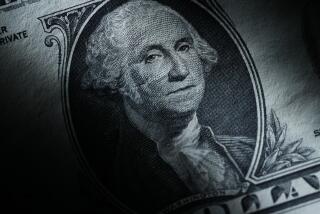Suddenly, Those Bank CD Yields Don’t Look Bad
- Share via
Your corner bank suddenly doesn’t look like such a bad place to keep some money.
With stock and bond markets slumping again, and with this week’s news of the first-ever failure of a money market mutual fund, federally insured bank certificates of deposit are gaining new luster with investors and savers.
It helps, of course, that CD yields are hitting their highest levels since mid-1992, as the Federal Reserve Board continues to push interest rates higher to brake the economy.
Bank Rate Monitor newsletter in North Palm Beach, Fla., says the average yield on one-year CDs nationwide has jumped from 4.19% to 4.44% just since Aug. 16--the last time the Fed raised rates. At the start of the year, one-year CDs averaged just 3.08%.
Americans are responding to the higher returns: The total of small CDs at banks and S&Ls; has risen $14 billion over the last few months, to $782 billion currently. Until last spring, that sum had been plunging virtually nonstop since January, 1990, when it stood at about $1.16 trillion.
It isn’t just higher yields that are bringing people back to CDs, though. Some investors undoubtedly are learning (or relearning) about risk this year. Bond mutual funds, in particular, have lost substantial principal value as rising interest rates have devalued older bonds in fund portfolios. Investors who thought bonds were just CD substitutes now know they aren’t.
What’s more, the failure of an institutional money market mutual fund this week because of losses on so-called derivative securities should remind investors that money funds aren’t federally guaranteed like bank CDs. There is risk in the funds--minimal for most, but it’s still there.
*
If you’re looking for the highest--and safest--return on your short-term savings, here’s a rundown of your options today:
* CDs. For Southern Californians, this is a good time to be CD rate-shopping. Bradshaw Financial Network of San Rafael, which tracks yields for The Times, says average yields on six-month and one-year CDs among 30 California institutions are above national averages.
You’ll typically find the highest CD yields at “thrift and loans” that, unlike major banks and S&Ls;, tend to be smaller, specialized institutions. Santa Barbara-based California Thrift & Loan, for example, now pays 5.34% on a one-year CD, well above the 4.64% state average.
California Thrift mostly makes auto and home equity loans, and doesn’t provide the full range of “free” services that larger institutions offer consumers, says Robert Heavner, executive vice president. That keeps costs lower and allows the thrift to pay higher yields to depositors, he says. Like its larger competitors, however, it is covered by the same standard federal deposit insurance of $100,000 per account name.
The lowest yields, meanwhile, are usually found at the state’s biggest banks. Wells Fargo’s one-year CD yield, for example, is now 4.5%.
CD shoppers should check the weekly Bradshaw survey that appears each Monday in The Times Business section. Note: Even though you’ll find attractive yields on one-year and longer-term CDs, most financial advisers suggest keeping most of your savings in CDs of six months or less--as long as interest rates are still on the rise.
* Money market mutual funds. If you want an account that pays well, preserves your principal and offers immediate access (unlike CDs), money funds still are the best choice. The current national average yield on general money funds is 4.29%, according to fund-tracker IBC/Donoghue. That’s up from 2.7% at the start of the year, and will continue to rise with market interest rates.
This week’s failure of a Denver-based money fund, while shocking, shouldn’t worry most fund investors, experts say. That fund had no small investors in it, and it had gone far overboard investing in exotic derivative securities that the vast majority of funds don’t touch.
More important, the Denver fund lacked a deep-pocketed parent. More than a dozen other money funds would have suffered small principal losses this year because of derivatives, but their parent companies (like BankAmerica and Paine Webber, to name two) bailed them out.
The moral: Because most investors don’t have the ability to analyze what’s in a fund portfolio, anyone worried about trouble ought to stick with funds backed by major financial institutions.
* U.S. Treasury bills. Many savers forget about Treasuries. They shouldn’t. The yield on six-month T-bills now is 5.4%, dramatically better than the 3.7% national average on six-month CDs. One-year T-bills yield 5.9%. And, unlike CDs, T-bill interest is exempt from state income tax. If you’ve got at least $10,000, you can buy a T-bill, and you can buy it direct from Uncle Sam. For order forms, call (213) 624-7398.
CD Yields Surge
Average yields on bank certificates of deposit nationwide on Jan. 1, on Aug. 16 (the date of the last Federal Reserve rate increase) and currently:
6-month: Jan. 1: 2.78% Aug. 16: 3.53% Now: 3.70%
1-year: Jan. 1: 3.08% Aug. 16: 4.19% Now: 4.44%
5-year: Jan. 1: 4.65% Aug. 16: 5.53% Now: 5.75%
Source: Bank Rate Monitor
More to Read
Inside the business of entertainment
The Wide Shot brings you news, analysis and insights on everything from streaming wars to production — and what it all means for the future.
You may occasionally receive promotional content from the Los Angeles Times.










